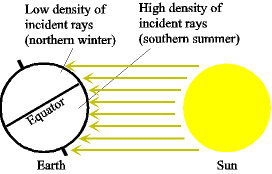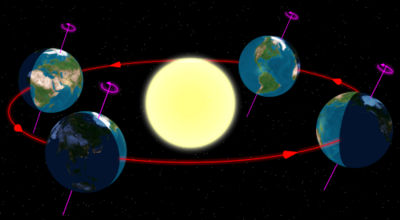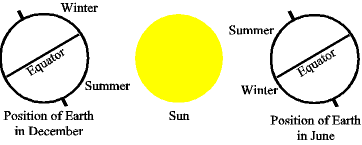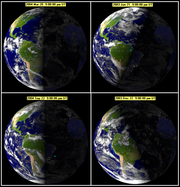Season
2007 Schools Wikipedia Selection. Related subjects: Climate and the Weather; Everyday life
|
|
|---|
|
|
|
|
|
|
|---|
|
|
|
|
|
|
|
|
A season is one of the major divisions of the year, generally based on yearly periodic changes in weather.
In temperate and polar regions generally four seasons are recognized: spring, summer, autumn (fall), and winter.
In some tropical and subtropical regions it is more common to speak of the rainy (or wet, or monsoon) season versus the dry season, as the amount of precipitation may vary more dramatically than the average temperature.
In other tropical areas a three-way division into hot, rainy and cool season is used. In some parts of the world, special "seasons" are loosely defined based upon important events such as a hurricane season, tornado season, wildfire season or a sport season.
Causes and climatic effects

This is a diagram of the seasons. Note that, regardless of the time of day (i.e. the Earth's rotation on its axis), the North Pole will be dark, and the South Pole will be illuminated; see also arctic winter. In addition to the density of incident light, the dissipation of light in the atmosphere is greater when it falls at a shallow angle.
The seasons result from the Earth's axis being tilted to its orbital plane; it deviates by an angle of approximately 23.5 degrees of arc. Thus, at any given time during the summer or winter, one part of the planet is more directly exposed to the rays of the Sun (see Fig. 1). This exposure alternates as the Earth revolves in its orbit. At any given time, regardless of season, the northern and southern hemispheres experience opposite seasons (see Fig. 2 and Month ranges of seasons (below) and Effect of sun angle on climate).
Seasonal weather fluctuations also depend on factors such as proximity to oceans or other large bodies of water, currents in those oceans, El Niño/ENSO and other oceanic cycles, and prevailing winds.
In the temperate and polar regions, seasons are marked by changes in the amount of sunlight, which in turn often cause cycles of dormancy in plants and hibernation in animals. These effects vary with latitude, and with proximity to bodies of water. For example, the South Pole is in the middle of the continent of Antarctica, and therefore a considerable distance from the moderating influence of the southern oceans. The North Pole is in the Arctic Ocean, and thus its temperature extremes are buffered by the presence of all that water. The result is that the South Pole is consistently colder during the southern winter than the North Pole during the northern winter.
The cycle of seasons in the polar and temperate zones of one hemisphere is opposite to that in the other. When it is summer in the Northern hemisphere, it is winter in the Southern hemisphere, and vice versa, and when it is spring in the Northern hemisphere it is autumn in the Southern hemisphere, and vice versa.
In the tropics, there is no noticeable change in the amount of sunlight. However, many regions (famously the northern Indian Ocean) are subject to monsoon rain and wind cycles. Curiously, a study of temperature records over the past 300 years (David Thompson, Science, April 1995) shows that the climatic seasons, and thus the seasonal year, are governed by the anomalistic year rather than the tropical year.
In meteorological terms, the winter solstice and summer solstice (or the date maximum/minimum insolation) do not fall in the middle of winter and summer respectively. The heights of these seasons occur up to a month later due to seasonal lag. Seasons though, are not always defined in meteorological terms; see reckoning
Compared to axial tilt, other factors contribute little to seasonal temperature changes. It's a common misconception that the seasons are the result of the variation in Earth’s distance to the sun due to its elliptical orbit. Orbital eccentricity can influence temperatures, but on Earth, this effect is small and is more than counteracted by other factors; research shows that the Earth as a whole is actually a few degrees warmer when farther from the sun. Mars however experiences wide temperature variations and violent dust storms every year at perihelion.
Polar day and night
A common misconception is that, within the Arctic and Antarctic Circles, the sun rises once in the spring and sets once in the fall; thus, the day and night are erroneously thought to last uninterrupted for 183 calendar days each. This is true only in the immediate region of the poles themselves.
What does happen is that any point north of the Arctic Circle or south of the Antarctic Circle will have one period in the summer when the sun does not set, and one period in the winter when the sun does not rise. At progressively higher latitudes, the periods of " midnight sun" (or "midday dark" for the other side of the globe) are progressively longer. For example, at the military and weather station called Alert on the northern tip of Ellesmere Island, Canada (about 450 nautical miles or 830 km from the North Pole), the sun begins to peek above the horizon in mid-February and each day it climbs a bit higher, and stays up a bit longer; by 21 March, the sun is up for 12 hours. However, mid-February is not first light. The sky (as seen from Alert) has been showing twilight, or at least a pre-dawn glow on the horizon, for increasing hours each day, for more than a month before that first sliver of sun appears.
In the weeks surrounding 21 June, the sun is at its highest, and it appears to circle the sky without ever going below the horizon. Eventually, it does go below the horizon, for progressively longer and longer periods each day until, around the middle of October, it disappears for the last time. For a few more weeks, "day" is marked by decreasing periods of twilight. Eventually, for the weeks surrounding 21 December, nothing breaks the darkness. In later winter, the first faint wash of light briefly touches the horizon (for just minutes per day), and then increases in duration and pre-dawn brightness each day until sunrise in February.
Reckoning
The date at which each season begins depends on how it is defined. In the United States, the seasons are often considered to begin at the astronomical solstices and equinoxes: these are sometimes known as the " astronomical seasons". By this reckoning, summer begins at summer solstice, winter at winter solstice, spring at the vernal equinox and autumn at the autumnal equinox.
United Kingdom and Ireland have no hard and fast rules about seasons, but most follow the equinoxes and solstices; However informally many people use three calendar months for each season with Spring being March, April and May, etc.
It is interesting to note that historically seasons were considered to begin about 4 weeks earlier than the meteorological seasons, and seven weeks earlier than the astronomical seasons:
- spring began on February 2 / Candlemas or February 1 / Imbolc,
- summer on May 1st / May Day/ Beltane ,
- autumn on August 1st / Lammas/ Lughnasadh, and
- winter on November 1st / All Hallows / Samhain.
Accordingly, midsummer and midwinter were, as their names suggest, the middle of summer and winter.
So, in meteorology for the Northern hemisphere:
- spring begins by convention on March 1,
- summer on June 1,
- autumn on September 1 and
- winter on December 1.
This definition is also followed in Denmark and former USSR.
Conversely, for the Southern hemisphere, meteorological
- summer begins on December 1,
- autumn on March 1,
- winter on June 1 and
- spring on September 1.
This definition is also followed in Australia.
The Chinese, Japanese, and Korean calendars are based on a lunisolar calendar, where the solstices and equinoxes mark the middle of each season. This is very close to the British & Irish definitions of seasons. See below, using solstices and equinoxes as mid-days.
| Northern Hemisphere | Month | Southern Hemisphere | |||
|---|---|---|---|---|---|
| Traditional | Meteorological | Astronomical | Meteorological | Astronomical | |
| Winter | Winter | Winter | January | Summer | Summer |
| Spring | February | ||||
| Spring | March | Autumn | |||
| Spring | April | Autumn | |||
| Summer | May | ||||
| Summer | June | Winter | |||
| Summer | July | Winter | |||
| Autumn | August | ||||
| Autumn | September | Spring | |||
| Autumn | October | Spring | |||
| Winter | November | ||||
| Winter | December | Summer | |||
Mid-season
| year | Equinox Mar |
Solstice June |
Equinox Sept |
Solstice Dec |
||||
|---|---|---|---|---|---|---|---|---|
| day | time | day | time | day | time | day | time | |
| 2002 | 20 | 19:16 | 21 | 13:24 | 23 | 04:55 | 22 | 01:14 |
| 2003 | 21 | 01:00 | 21 | 19:10 | 23 | 10:47 | 22 | 07:04 |
| 2004 | 20 | 06:49 | 21 | 00:57 | 22 | 16:30 | 21 | 12:42 |
| 2005 | 20 | 12:33 | 21 | 06:46 | 22 | 22:23 | 21 | 18:35 |
| 2006 | 20 | 18:26 | 21 | 12:26 | 23 | 04:03 | 22 | 00:22 |
| 2007 | 21 | 00:07 | 21 | 18:06 | 23 | 09:51 | 22 | 06:08 |
| 2008 | 20 | 05:48 | 20 | 23:59 | 22 | 15:44 | 21 | 12:04 |
| 2009 | 20 | 11:44 | 21 | 05:45 | 22 | 21:18 | 21 | 17:47 |
| 2010 | 20 | 17:32 | 21 | 11:28 | 23 | 03:09 | 21 | 23:38 |
| 2011 | 20 | 23:21 | 21 | 17:16 | 23 | 09:04 | 22 | 05:30 |
| 2012 | 20 | 05:14 | 20 | 23:09 | 22 | 14:49 | 21 | 11:11 |
| 2013 | 20 | 11:02 | 21 | 05:04 | 22 | 20:44 | 21 | 17:11 |
| 2014 | 20 | 16:57 | 21 | 10:51 | 23 | 02:29 | 21 | 23:03 |
In the conventional US calendar, the following dates are considered to be halfway through a season:
- Winter ( February 3)
- Spring ( May 5 or May 6)
- Summer ( August 7)
- Autumn ( November 6)
Using solstices and equinoxes as Middle of Season
When the solstices (peaks) are used as the middle of each season, as is in Jieqi and East Asian countries, the longest day of the year occurs in the middle of summer, and conversely the shortest day of the year in the middle of winter.
So, in the Northern Hemisphere:
- Spring begins ( February 3)
- Summer begins ( May 5 or May 6)
- Autumn begins ( August 7)
- Winter begins ( November 6)
In the Southern Hemisphere:
- Autumn begins ( February 3)
- Winter begins ( May 5 or May 6)
- Spring begins ( August 7)
- Summer begins ( November 6)
Seasons in images
In hemiboreal and temperate climates:








